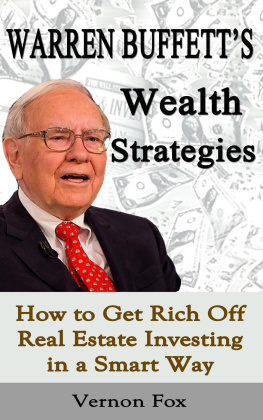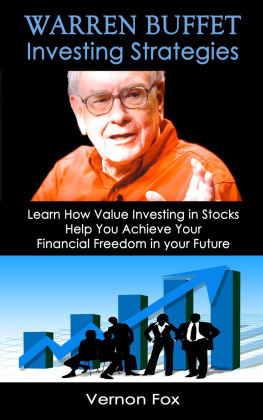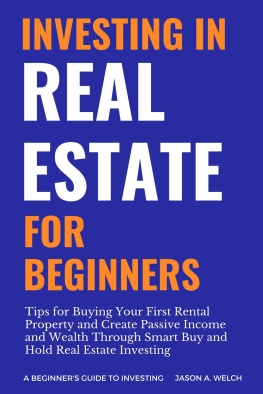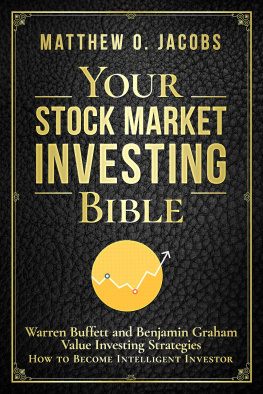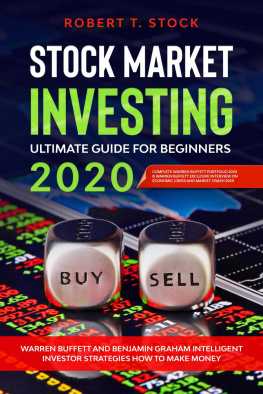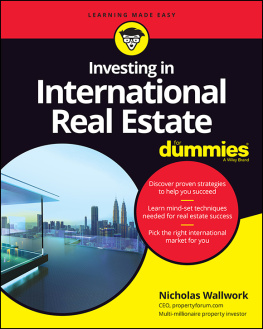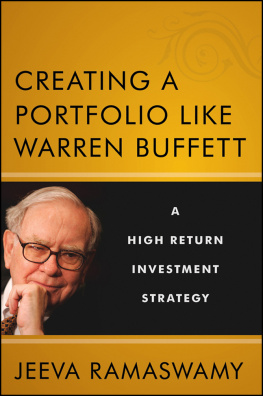Warren Buffetts Wealth Strategies
How to Get Rich Off Real Estate Investing in a Smart Way
Vernon Fox
A ll rights reserved . Without limiting the rights under copyright reserved above, no part of this publication maybe reproduced, stored in or introduced into a retrieval system, or transmitted in any form, or by any means (electronic, mechanical, photocopying, recording or otherwise) without the prior written permission of both the copyright owner and the publisher of this book. Please purchase only authorized electronic editions, and do not participate in or encourage electronic piracy of copyrighted materials.
ISBN-10: 1500959901
ISBN-13: 978-1500959906
Table of Contents
T his book is for those who want to learn how Warren Buffett became rich through investing in real estate. Through this book you will learn how to get rich by investing in a smart way. Some people think that investing in real estate is only for the rich. Perhaps it was true in the past but at present its a different story. Warren Buffetts road to success was quite bumpy, but he managed to learn the right strategy with the help of his mentor Benjamin Graham.
Chapter 1 includes the personal life of Warren Buffett as well as some of the important highlights of his childhood life. His encounter with his mentor Benjamin Graham was not love at first sight at all. The truth is, he was rejected at first, but Graham realized something great will happen and reconsidered hiring Buffett.
Chapter 2 discusses in brief the 5 fundamentals of real estate investing according to Warren Buffett.
Chapter 3 to 7 discusses these fundamentals in detail to clearly describe to readers the strategy that Buffett applied in investing.
Through this book, you will have an idea on what to expect and what to consider in investing in real estate.
Chapter 1 Warren Buffetts Road to Success
W arren Buffett is a popular value investor. He was able to transform a troubled textile mill into a financial engine which is now considered as the most successful holding company in the world.
Buffett is also known as the Oracle of Omaha. Because of his investment power, he has collected a personal fortune in excess of $62 billion, which makes him the top man on the Forbes Worlds Billionaires List in 2008. Buffett inspires lots of loyal fans to make an annual trek to Omaha for a chance to hear him speak during Berkshire Hathaways annual meeting, an occasion dubbed as the Woodstock of Capitalism.
Buffetts Early Years
W arren Buffett was born in Omaha, Nebraska to Leila and Howard Buffett on August 30, 1930. He was the only son and the second of three children born to the couple. Buffetts father was a stockholder and was a congressman. Howard Buffett served non-consecutive terms under the Republican ticket, but adopted libertarian points of view.
Buffetts interest in making money started at an early age when he sold soft drinks and newspapers. At the age of 14, he invested his earnings from these endeavors in forty acres of land, which he then rented out for a profit. His father encouraged him to enroll at the University of Pennsylvania and he was accepted. He was not satisfied and after two years he left and transferred to the University of Nebraska.
After graduating, his father again convinced him to pursue a graduate degree. He was rejected by Harvard University, but was accepted at Columbia. He was under Benjamin Graham, who is known as the father of value investing. Warren Buffetts time at Columbia set the stage for his career, although with a slow start.
Graham refused to hire him. Graham even suggested that he stay away from Wall Street. Howard agreed with Benjamin Graham, and advised Warren to return to Omaha to work with him in a brokerage firm. Warren married Susan Thompson, and the couple had two children. Graham changed his mind and asked Buffett to work in New York.
The Foundation of Value
B uffett had the opportunity to build upon the investing theories he learned from Graham while working in New York. According to Graham, value investing involves searching for stocks that are offered at an extraordinary discount to the value of the underlying assets, which Graham called the intrinsic value.
Warren internalized the idea, but thought of taking it even further. Unlike Benjamin Graham, he wanted to focus not only on numbers, but also on the companys management team and the products competitive advantage in the marketplace.
He returned to Omaha and launched Buffett Associates, Ltd, in 1956 and bought a house. At the of 30, he was already a millionaire when he worked together with Charlie Munger. Their teamup eventually resulted in the creation of an investment philosophy taken from Buffetts idea of looking at value investing as more than an attempt to squeeze the last few dollars out of troubled businesses.
Along the way, they purchased the troubled textile mill Berkshire Hathaway. What started out as a classic Benjamin Graham value play transformed into a long-term investment when the business displayed some signs of hope.
Cash flows from the textile business were utilized to fund other investments. Eventually, the original textile business was outshone by other holdings. Buffett decided to shut down the textile firm in 1985, but used the name in other businesses.
Buffetts philosophy in investment become one based on the principle of getting stocks in what he thinks are well-handled, undervalued companies. Each time he makes a purchase, his purpose is to hold the securities indefinitely.
American Express, Gilette Company and Coca Cola all met his criteria and have stayed with Berkshire Hathaways portfolio for several years. In most cases, he bought the companies outright, allowing their management teams to manage the business. Some of the companies that fall into this category are Fruit of the Loom, The Pampered Chef, Sees Candles, GEICO Auto Insurance and Dairy Queen.
Next page
